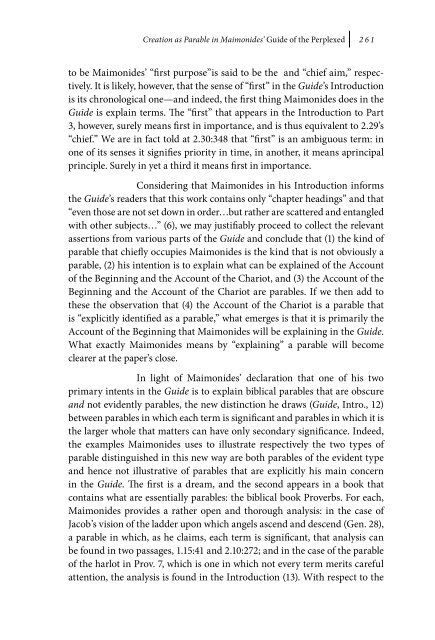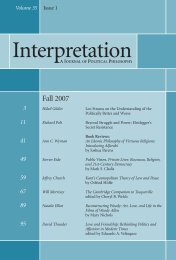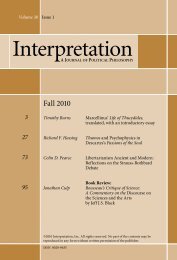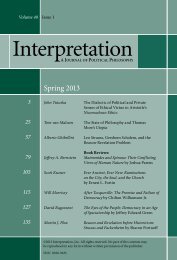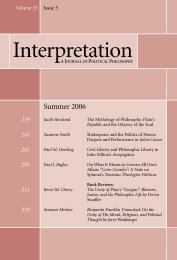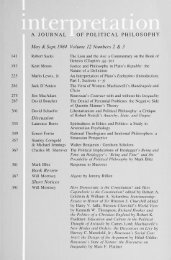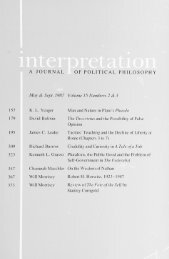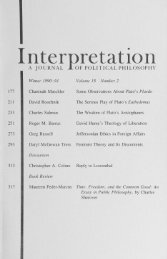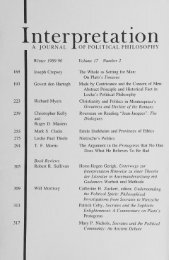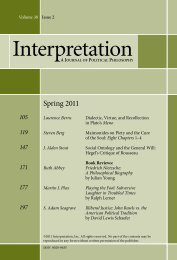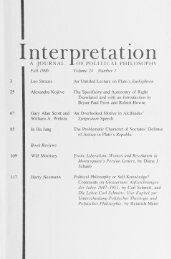Spring 2010 - Interpretation
Spring 2010 - Interpretation
Spring 2010 - Interpretation
You also want an ePaper? Increase the reach of your titles
YUMPU automatically turns print PDFs into web optimized ePapers that Google loves.
Creation as Parable in Maimonides’ Guide of the Perplexed<br />
2 6 1<br />
to be Maimonides’ “first purpose”is said to be the and “chief aim,” respectively.<br />
It is likely, however, that the sense of “first” in the Guide’s Introduction<br />
is its chronological one—and indeed, the first thing Maimonides does in the<br />
Guide is explain terms. The “first” that appears in the Introduction to Part<br />
3, however, surely means first in importance, and is thus equivalent to 2.29’s<br />
“chief.” We are in fact told at 2.30:348 that “first” is an ambiguous term: in<br />
one of its senses it signifies priority in time, in another, it means aprincipal<br />
principle. Surely in yet a third it means first in importance.<br />
Considering that Maimonides in his Introduction informs<br />
the Guide’s readers that this work contains only “chapter headings” and that<br />
“even those are not set down in order…but rather are scattered and entangled<br />
with other subjects…” (6), we may justifiably proceed to collect the relevant<br />
assertions from various parts of the Guide and conclude that (1) the kind of<br />
parable that chiefly occupies Maimonides is the kind that is not obviously a<br />
parable, (2) his intention is to explain what can be explained of the Account<br />
of the Beginning and the Account of the Chariot, and (3) the Account of the<br />
Beginning and the Account of the Chariot are parables. If we then add to<br />
these the observation that (4) the Account of the Chariot is a parable that<br />
is “explicitly identified as a parable,” what emerges is that it is primarily the<br />
Account of the Beginning that Maimonides will be explaining in the Guide.<br />
What exactly Maimonides means by “explaining” a parable will become<br />
clearer at the paper’s close.<br />
In light of Maimonides’ declaration that one of his two<br />
primary intents in the Guide is to explain biblical parables that are obscure<br />
and not evidently parables, the new distinction he draws (Guide, Intro., 12)<br />
between parables in which each term is significant and parables in which it is<br />
the larger whole that matters can have only secondary significance. Indeed,<br />
the examples Maimonides uses to illustrate respectively the two types of<br />
parable distinguished in this new way are both parables of the evident type<br />
and hence not illustrative of parables that are explicitly his main concern<br />
in the Guide. The first is a dream, and the second appears in a book that<br />
contains what are essentially parables: the biblical book Proverbs. For each,<br />
Maimonides provides a rather open and thorough analysis: in the case of<br />
Jacob’s vision of the ladder upon which angels ascend and descend (Gen. 28),<br />
a parable in which, as he claims, each term is significant, that analysis can<br />
be found in two passages, 1.15:41 and 2.10:272; and in the case of the parable<br />
of the harlot in Prov. 7, which is one in which not every term merits careful<br />
attention, the analysis is found in the Introduction (13). With respect to the


